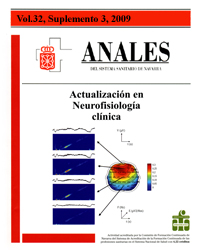Physiopathology and recording techniques of the ocular movements
DOI:
https://doi.org/10.23938/ASSN.0152Keywords:
Movimientos oculares. Sacadas. Seguimiento ocular. Espiga presacádica. Supresión sacádica.Abstract
A number of functional systems are involved in the control of eye movements. The vestibulo-ocular and optokinetic reflexes are automatic responses that compensate for the movements of the head and those of the visual environment in order to stabilize the retinal image on a given fixation point. The saccadic movements are quick displacements of fixation from one to another point in the visual field. The smooth pursuit movements consist in the gaze following a moving target. Finally, there are some involuntary movements of very small amplitude during fixation maintenance. Each functional modality of movement depends on specific neuronal circuits that work in a coordinated manner for encoding the contraction of the oculomotor muscles to reach an adequate position at every moment. These neuronal systems can be altered by many neurological processes of different kinds and localizations, causing a broad variety of oculomotor disturbances. The most salient aspects of the physiopathology and the recording systems of eye movements are reviewed.Downloads
Downloads
Published
How to Cite
Issue
Section
License
La revista Anales del Sistema Sanitario de Navarra es publicada por el Departamento de Salud del Gobierno de Navarra (España), quien conserva los derechos patrimoniales (copyright ) sobre el artículo publicado y favorece y permite la difusión del mismo bajo licencia Creative Commons Reconocimiento-CompartirIgual 4.0 Internacional (CC BY-SA 4.0). Esta licencia permite copiar, usar, difundir, transmitir y exponer públicamente el artículo, siempre que siempre que se cite la autoría y la publicación inicial en Anales del Sistema Sanitario de Navarra, y se distinga la existencia de esta licencia de uso.








